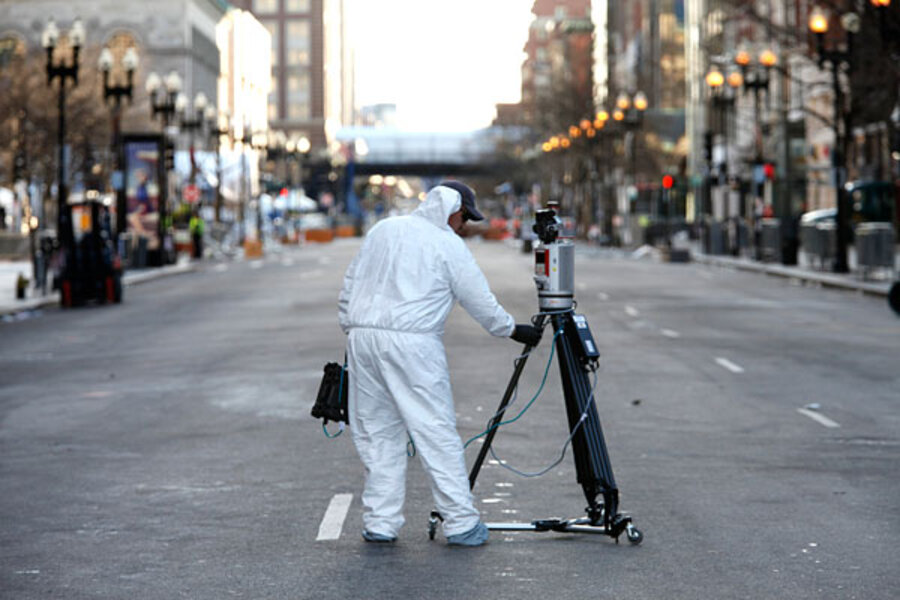Whirlwind day in Boston bombing case ends, search for mystery man begins
Loading...
| Boston
Investigators in the Boston Marathon bombing case were reported Wednesday to have located key video images of a still-unidentified male depositing a bag on the ground near the site of the second of two explosions at the race, according to several news outlets.
Those findings remained at the end of a blustery media day gusting with other reports that turned out to be false, including the claim that a suspect had been arrested. But federal and Boston-area law enforcement sources, speaking only on condition of anonymity, continued to maintain that “significant progress” had been made toward identifying a suspect in Monday’s twin bombings, according to various sources that included CNN and The Boston Globe.
The FBI’s afternoon briefing in Boston was pushed back from its original 5 p.m. start time – and later cancelled – after a day in which leaks from unnamed law enforcement sources to a few media outlets led to confusion about progress in the bombing investigation.
One federal law enforcement source in Washington, who is unauthorized to comment on the bombing probe, described it as “the leakiest investigation” he had witnessed. Another law enforcement source said the delay in the afternoon press briefing reflected, in part, an effort “to get all the different [law enforcement] agencies on the same page.”
Other speculation on why the briefing was delayed and finally cancelled included the possibility that pictures of a suspect or suspects would be issued, prompting careful evaluation of where that step might lead. Or perhaps officials felt they were on the verge of further progress in the search for the responsible parties, and the FBI wanted to be sure that would not be jeopardized by publicly divulging information.
Earlier Wednesday, some media reported that a suspect in the bombings had been arrested, in one case based on a claim from an unnamed Boston law enforcement official that “we got him.”
Subsequent reports confirmed that the FBI had isolated at least one suspicious individual in videotape, reportedly from a surveillance camera at Lord & Taylor department store, but the FBI issued a statement stating that no one was in custody as of Wednesday afternoon.
“Contrary to widespread reporting, no arrest has been made in connection with the Boston Marathon attack,” FBI spokeswoman Katherine Gulotta said in a statement. “Over the past day and a half, there have been a number of press reports based on information from unofficial sources that has been inaccurate. Since these stories often have unintended consequences, we ask the media, particularly at this early stage of the investigation, to exercise caution and attempt to verify information through appropriate official channels before reporting.”
A certain amount of confusion and mixed information is not surprising, law enforcement experts say, given the large number of local, state, and federal agencies involved, and the variety of interests they represent.
But while some law enforcement representatives may be eager to encourage a sense of progress in the investigation, some national security experts note that the FBI is in charge of the investigation and that its focus is on getting the investigation right – arresting the right individuals so that the case holds up.
As the official investigation moved forward, a parallel probe was being carried out by amateur sleuths online. The armchair detectives are busy analyzing the many photos available online, showing the Marathon Day finish line both before and after the blasts.
In effect, the investigation has become partly “crowd-sourced” – farmed out (intentionally or not) to public forums where people are sifting photos for clues. Many images are now annotated with colored circles around potential clues, such as an individual labeled with “bag” in one photo and “no bag” in another.
Some news reports have said FBI investigators are interested in tracking down a man who, in the surveillance camera footage, was wearing a white cap (facing backward), dark jacket, and gray hoodie sweatshirt.
In the parallel probe by the online community, various white-hatted individuals have been identified in photos of the scene, but not necessarily fully fitting the description in news reports.
• Staff writer Howard LaFranchi contributed to this story from Washington.





